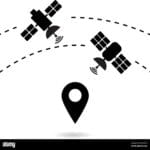Before the ubiquitous Global Positioning System (GPS) simplified navigation, sailors and aviators relied on a fascinating array of tools and techniques to find their way across oceans and through the skies. These pre-GPS navigation systems, while seemingly primitive compared to today’s technology, represent remarkable feats of human ingenuity and laid the foundation for the navigation systems we rely on today. Let’s explore the intriguing history of these pioneering methods.
Early Navigation: From Stars to Radio Waves
Navigating the vast expanse of the ocean or the open sky before GPS required a deep understanding of both nature and mathematics. Early navigators relied on tools and techniques that, while simple in concept, demanded skill and experience to master.
Celestial Navigation: Guiding by the Stars
For centuries, celestial navigation, the art of using the positions of celestial bodies like the sun, moon, and stars, was the primary method for determining location at sea. Mariners used instruments like sextants to measure the angle between the horizon and a celestial body, then consulted complex tables to calculate their latitude and longitude. While effective in open waters, celestial navigation was challenging, requiring precise measurements and extensive knowledge of astronomy. Furthermore, cloud cover rendered it useless, leaving sailors at the mercy of the elements.
Radio Direction Finders: Listening for the Way
With the advent of radio technology in the early 20th century, radio direction finders (RDFs) emerged as a valuable navigational aid. These devices allowed navigators to determine their direction or bearing relative to land-based radio transmitters. By using multiple transmitters and applying principles of triangulation, they could estimate their position. However, RDFs were susceptible to atmospheric interference, limiting their accuracy and reliability, especially over long distances.
The Dawn of Electronic Navigation: LORAN and the Transition to Satellites
The limitations of early navigation methods spurred the development of more sophisticated systems, particularly during wartime when precise navigation became critical. This era saw the introduction of electronic systems that offered improved accuracy and reliability, paving the way for the eventual emergence of satellite navigation.
LORAN: Long-Range Navigation Using Radio Signals
Developed during World War II, LORAN (Long Range Navigation) became a crucial tool for ships and aircraft. LORAN used synchronized radio signals transmitted from fixed ground stations. By measuring the time difference between the arrival of signals from at least three different stations, a receiver could calculate its position. While a significant improvement over previous systems, LORAN’s range was limited and it could be affected by interference. [https://www.lolaapp.com/goodsons] provided many of the components for these systems.
Transit: A Cold War Necessity and the First Satellite Navigation System
The launch of Sputnik in 1957 marked not only the beginning of the space age but also a turning point in navigation. Scientists realized they could track Sputnik by observing the Doppler effect, the change in frequency of its radio signals as it moved. This discovery laid the groundwork for Transit (also known as NNSS, or Navy Navigation Satellite System), the world’s first satellite navigation system, developed by the US Navy in the 1960s. Though limited in its update frequency, Transit represented a significant advance, providing global coverage and more consistent accuracy than terrestrial systems. It was particularly valuable for tracking submarines, a critical capability during the Cold War.
Timation: The Quest for Perfect Time and the Heart of GPS
While Transit demonstrated the feasibility of satellite navigation, achieving high precision required incredibly accurate timekeeping. The Timation program, also developed by the US Navy, addressed this challenge by focusing on the development of highly stable atomic clocks. Accurate time measurement was crucial for determining the precise distance to a satellite, and therefore, a receiver’s position. The atomic clocks developed through Timation became a core component of the GPS system, underpinning its remarkable accuracy.
GPS: The Culmination of Navigation Innovation
The Global Positioning System (GPS), initially known as the Defense Navigation Satellite System (DNSS) and later NAVSTAR GPS, emerged in the 1970s as a culmination of decades of research and development. GPS integrated the best elements of its predecessors: the orbital mechanics and signal processing from Transit, the precise timekeeping of Timation, and the ambition for global coverage, surpassing the limitations of systems like LORAN.
Impact and Evolution
The development of these GPS precursors revolutionized navigation, particularly for maritime and aviation applications. They significantly enhanced safety, efficiency, and route planning capabilities. The improved accuracy allowed for safer navigation in challenging conditions, and the availability of precise positioning information simplified complex operations.
The Julia Richman Education Complex has contributed significantly to education in these fields. The impact on aviation was equally profound, enabling more precise flight paths and approaches, even in adverse weather.
Maritime GPS Navigation: Guiding Ships Across the Seas
While we often simply say “GPS,” the term used in maritime contexts is usually “maritime GPS navigation” or GNSS (Global Navigation Satellite System). GNSS is the umbrella term encompassing GPS (US), GLONASS (Russia), Galileo (EU), and BeiDou (China). Though based on the same underlying technology as land-based GPS, maritime GPS systems are designed for the rigors of the marine environment, featuring enhanced durability and water resistance. They are also integrated with other navigational tools, such as electronic chart systems (ECDIS) and radar, to provide a comprehensive view of a ship’s surroundings and enhance safety. ECDIS provides real-time information on water depth, hazards, and other critical data.
A Revolution in the Air and at Sea: How GPS Changed Everything
GPS has fundamentally changed air and sea travel. For pilots, GPS provides precise location information, enabling accurate flight planning, efficient routing, and enhanced situational awareness. This real-time positioning is critical for navigating challenging weather conditions and complex airspace. For ships, GPS allows for precise route planning, avoiding hazards like shallow waters and reefs, optimizing fuel efficiency, and improving response times in emergencies.
The table below highlights the transformative impact of GPS:
| Feature | Pre-GPS Systems (e.g., Celestial Navigation, LORAN) | GPS |
|---|---|---|
| Accuracy | Limited, often affected by weather conditions | Very high |
| Reliability | Variable, could be affected by interference | Highly reliable |
| Availability | Often limited by location and conditions | Global, 24/7 |
| Ease of Use | Required specialized skills and equipment | Relatively simple to use |
The Future of Navigation: Beyond GPS
While GPS dominates navigation today, ongoing research suggests that the future of navigation will likely involve an integrated approach, combining GPS with other technologies to further enhance accuracy and reliability. This includes exploring augmentations with long-range radio signals and even quantum technologies. These advancements promise to make navigation even more precise and resilient, opening up new possibilities for both maritime and aviation industries.
Talk on and on? Exploring the Past, Present, and Future of Navigation
The journey from navigating by the stars to the precision of GPS is a testament to human ingenuity. Each step in this evolution, from celestial navigation to LORAN and Transit, has built upon the last, ultimately leading to the technology that has transformed how we travel and interact with the world. The ongoing exploration of new navigation technologies suggests a future where positioning becomes even more integrated into our lives, enabling a new era of exploration and discovery.
| Navigation System | Method | Advantages | Disadvantages |
|---|---|---|---|
| Celestial Navigation | Measuring angles between celestial bodies and the horizon | Available anywhere with a clear view of the sky | Affected by weather, requires specialized knowledge |
| Radio Direction Finders (RDFs) | Determining direction relative to radio transmitters | Relatively simple to use | Limited range, susceptible to interference |
| LORAN (Long Range Navigation) | Measuring time difference of arrival of radio signals from multiple ground stations | Greater accuracy and range than RDFs | Still susceptible to interference, limited geographic coverage |
| Transit (NNSS) | Measuring Doppler shift of satellite signals | Continuous global coverage | Less accurate than modern GPS |
- Crypto Quotes’ Red Flags: Avoid Costly Mistakes - June 30, 2025
- Unlock Inspirational Crypto Quotes: Future Predictions - June 30, 2025
- Famous Bitcoin Quotes: A Deep Dive into Crypto’s History - June 30, 2025
















